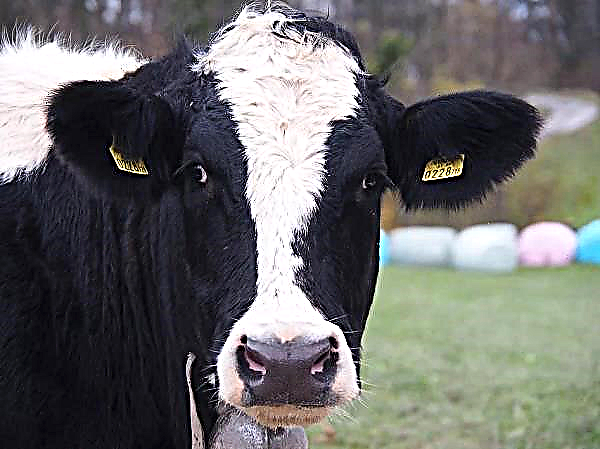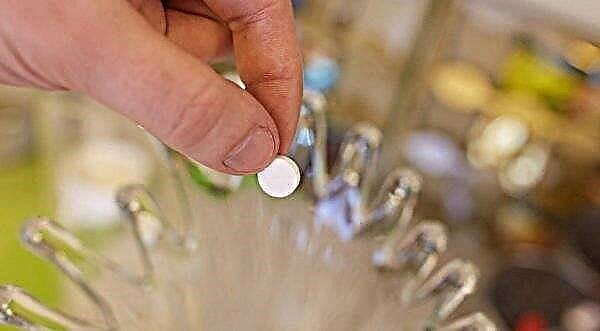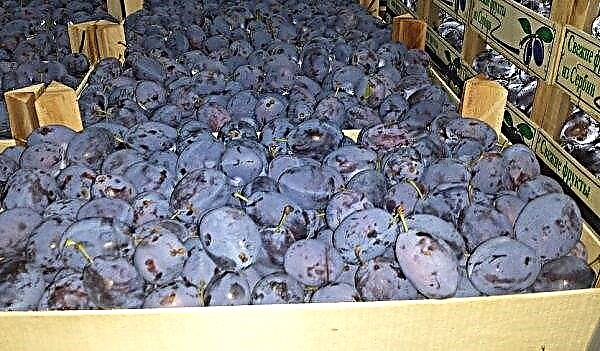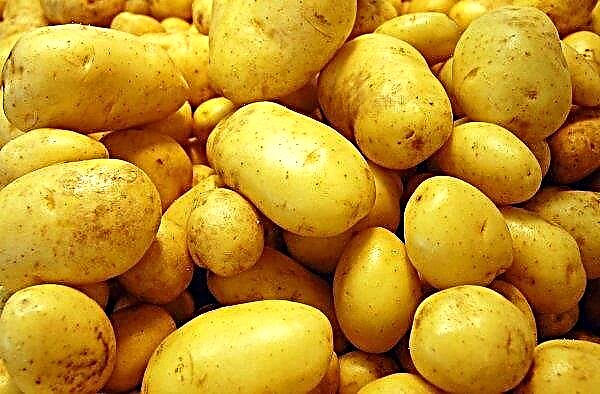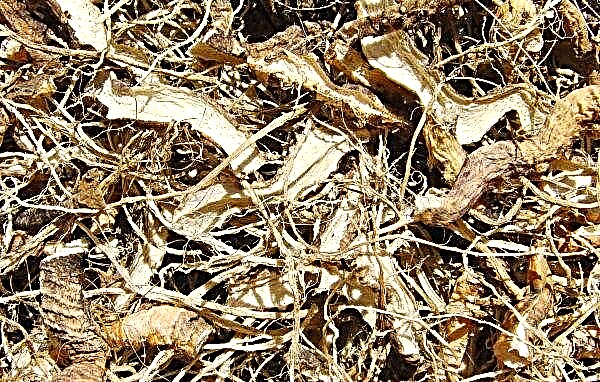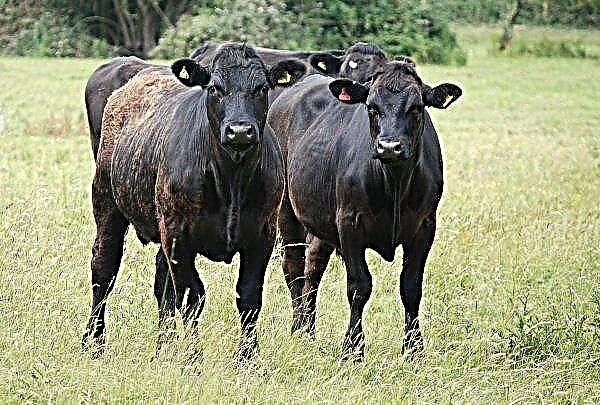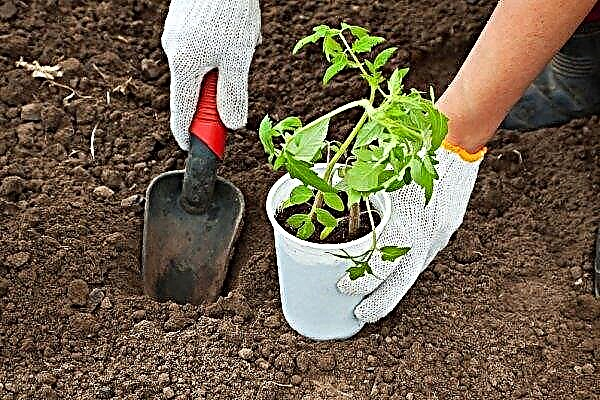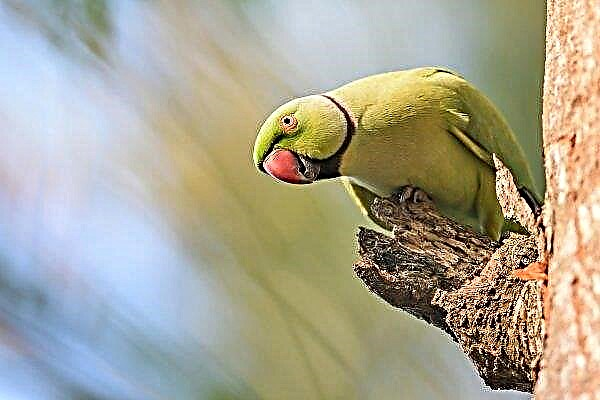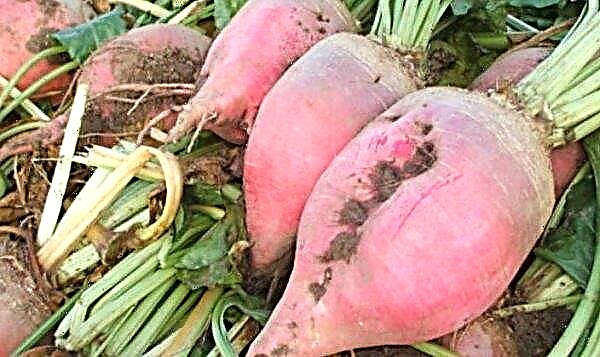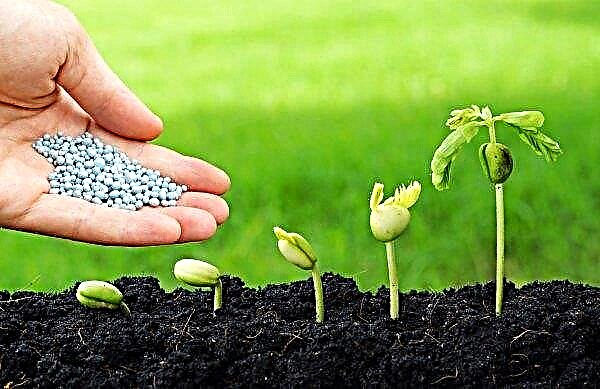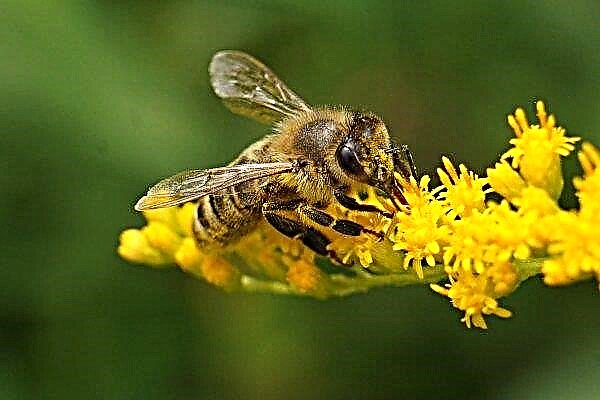A rare person will refuse at the end of a snowy winter from fresh, fragrant and crisp cucumber. That is why gardeners try to grow fresh cucumbers as early as possible. In this article, we will talk about the early hybrid of cucumber Grasshopper F1, its characteristics and description, as well as methods of growing this crop, will be given.
Characterization and description of the variety
 Cucumber Grasshopper is not a variety in the full sense of the word, it refers to hybrids and must be accompanied by an F1 icon, which means belonging to the first generation hybrid.
Cucumber Grasshopper is not a variety in the full sense of the word, it refers to hybrids and must be accompanied by an F1 icon, which means belonging to the first generation hybrid.
The hybrid was received by Russian breeders of the agricultural company "Manul" from the city of Mytishchi, located in the suburbs.
The main purpose of these cucumbers is early consumption, so such properties of the vegetable as early maturity, high yield and presentation of the fruits are important.
This is a very important quality when selling cucumbers at the highest price.
The stable yield of this cucumber is explained by its parthenocarpy: all the flowers on the plant are female and do not need additional pollination by bees or other insects. This hybrid can be grown both in a greenhouse and in open ground.
Grasshopper F1 is a vegetable with an early ripening period: the first cucumbers can be removed from the bush within 40 days after the emergence of seedlings on the soil surface.
The appearance of the bush
The main stem of the hybrid Grasshopper F1 is not too long and rarely exceeds 2 m. The length of the main stem of the vegetable depends on the hybrid growing conditions. On the street, the stem will have a length of up to 1.5 m, and in a heated greenhouse it will reach 2 m.
Lateral stems are located on the main stalk through 1-2 leaves and develop in the sinuses located between the leaf and the main stalk. The length of the lateral stems can reach 1.2 m. When forming a cucumber bush, gardeners usually cut the lateral lashes into 3-4 leaves or 20-30 cm in length.Did you know? Scientists of the International Space Station grew cucumbers in space to determine the factor that has the greatest influence on the development of the root system (water or gravity). The palm went to water.
The bush has good foliage. The leaves of this hybrid are wide, fleshy, consists of 5 segments, are painted in bright green color, soft and rough.
Features of the fruit
The Grasshopper hybrid F1 belongs to the bunch variety of cucumbers, that is, the fruits are tied in the leaf sinus not one or two, but a bundle consisting of 2-6 ovaries. Cucumbers are poured and ripened in a bunch not simultaneously, but sequentially, one after another.

Grasshopper F1 fruits are neat, small, cylindrical. The color of the cucumbers is dark green, the skin is slightly hilly, the shape of the cucumber has distinct longitudinal faces. On ripened fruits there are small whitish spikes.
The mass of an adult cucumber does not exceed 90–100 g, the maximum length of the fruit is 12 cm, and the diameter is 3.5 cm. The young fruits are juicy, crunchy, tasty and aromatic. Zelentsy covered with delicate skin. It is recommended to collect Grasshopper F1 fruits when they reach a length of 6–7 cm. Overripe cucumbers tend to form voids inside the fruit.
Fruitfulness
In order to get a good profit from the sale of cucumber fruits, the grower must provide a very early planting. For this, this hybrid is grown using seedlings, which after 30 days are planted in well-fertilized soil of a heated greenhouse. The yield of the hybrid is very high: in a greenhouse with an area of 10 m², with proper agricultural technology, you can get a crop of up to 150 kg of cucumbers.
Did you know? Tiberius, the ancient Roman emperor, was very fond of cucumbers and wanted to eat these vegetables all year round: in winter and in summer. The imperial desire served as an impetus for the creation of the world's first greenhouses by palace gardeners.
Advantages and disadvantages of the variety
Like many other hybrids, Grasshopper F1 differs from ordinary cucumber varieties in excellent yield. In addition, it is characterized by increased multiplicity due to the formation of a bundle of ovaries. Cucumbers are a low-calorie vegetable: 100 g of cucumber pulp contains only 30 calories.
- Positive aspects of the hybrid:
- excellent yield;
- rapid ripening of fruits;
- presentation of cucumbers;
- good taste;
- lack of a gene of bitterness in fruits;
- suitability for preservation and salting;
- prolonged and gradual bearing;
- lack of tendency to overgrow.
The negative side of the hybrid can only be attributed to unsuitability for collecting seeds for subsequent propagation.
Sowing and growing technology
Cucumbers can be sown directly in open ground or planted in seedlings in the garden. To obtain very early production, it is advisable to first grow seedlings.
You can calculate the time of sowing cucumber seeds for seedlings as follows: 35 days are counted back from the estimated date of planting seedlings in the ground. This will be the optimal date for sowing seeds for seedlings. Sowing seeds too early is not recommended because plants should not grow in containers.
How to grow cucumber seedlings:
- Seeds are sown in planting containers with a volume of at least 0.5 liters per plant. Pots for growing seedlings must have holes in the bottom to drain excess moisture. If the pots do not have drainage holes, the root system of the cucumber is likely to rot and the plant will become sick.
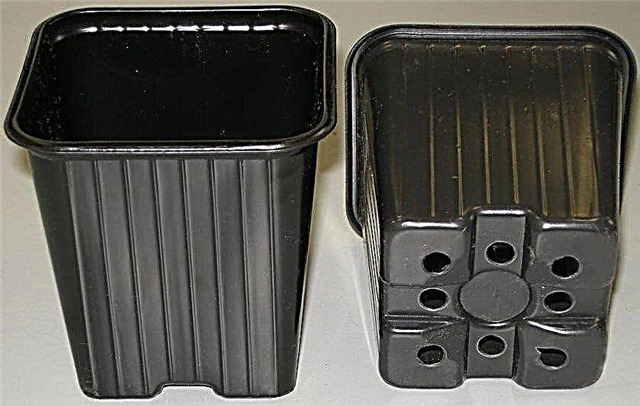
- Pre-mixed soil mixture consisting of equal parts of chernozem, humus and sand. It is also advisable to add several handfuls of wood ash to the soil mixture. Ready soil must be disinfected from pathogenic microorganisms, eggs and pest larvae. This can be done in two ways: pour the soil with boiling water or warm it in the oven for 20-30 minutes.
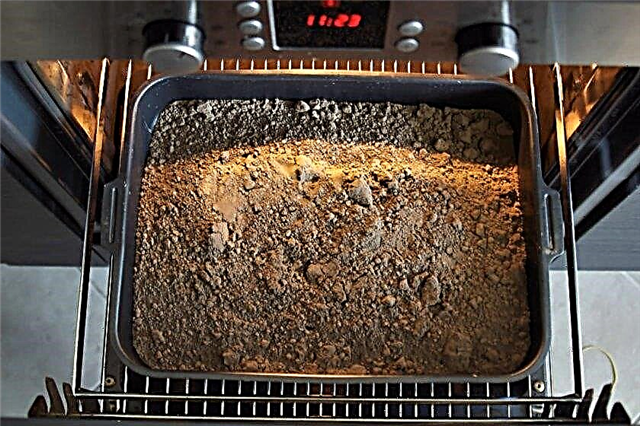
- The disinfected soil is poured into the pots so that almost 50% of the free space remains to the edge of the container. In the process of growing seedlings, the earth will be sprinkled under the root of the plant, thereby contributing to the growth of a well-developed root system.
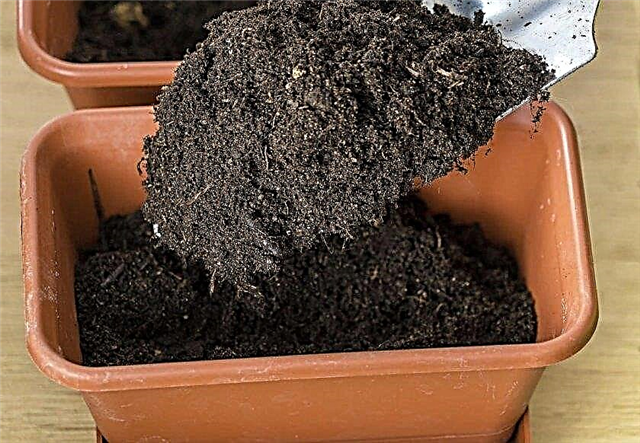
- In each container, 2 or 3 seeds are placed to a depth of 1 cm and tightly covered with soil.
- After sowing, the soil in the pots is well watered with warm water, it is expected that excess moisture will drain through the hole in the bottom of the container, and the pot is covered with a transparent plastic wrap.
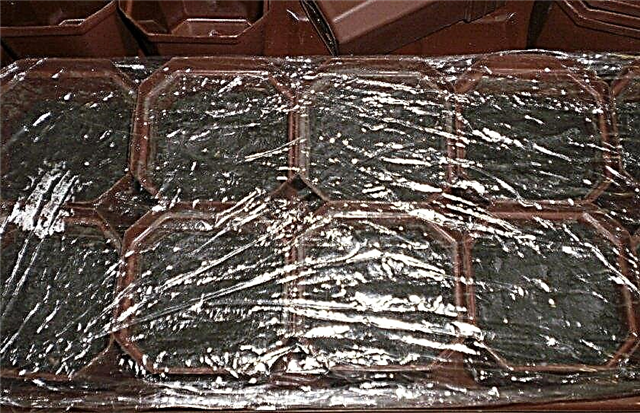
- Crop containers are installed in a room where the temperature does not fall below + 20 ° C. High temperature contributes to the rapid germination of seeds and the development of seedlings. If all the seeds in the pot sprout, only the strongest plant is left for further growth, the rest of the sprouts are cut at the soil level with sharp manicure scissors.
- As soon as the sprouts appear on the surface of the soil, the containers are rearranged closer to the light source. It can be either a window sill of a southern window or a special seedling table equipped with a lamp for illuminating plants. Transparent polyethylene is not removed from containers in which sprouts appeared for another 5–7 days. The film does not allow moisture to evaporate from the soil, thereby reducing the need for young plants for irrigation. Every day, the grower must remove the plastic film from the pot for 30 minutes to ventilate the seedlings.
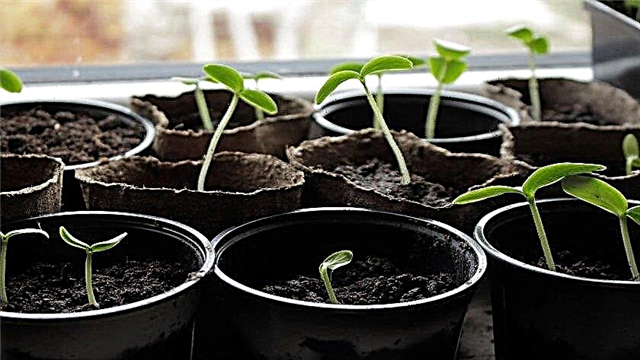
- Seedlings are watered as necessary, when the topsoil in the pot dries to a depth of 2 cm. Only warm water is used for irrigation. It is optimal to water cucumbers with melt or rain water. If chlorinated tap water is used, it must first be defended for several days.

- 15 days after the appearance of the sprouts, it is necessary to begin the hardening of young cucumber seedlings. In the first week of hardening, open the window in the room for 30–40 minutes, increasing the duration of the procedure every day. At the age of 25 days, seedlings begin to be taken out for hardening and adaptation to the street. Street hardening is carried out at an air temperature of at least + 20 ° C. On the street, seedlings are set in diffuse shade under the trees, as direct sunlight can damage delicate plants. On the first day of street hardening, the seedlings remain in the open air for an hour. Every day, the duration of street hardening increases until it reaches daylight hours.
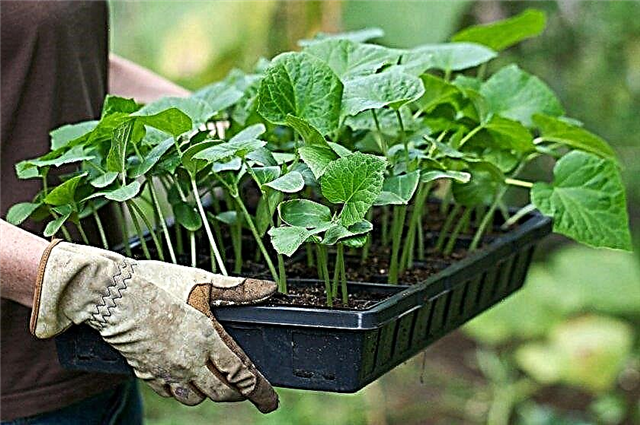
- It is optimal to plant cucumber seedlings in a permanent place at an age not exceeding 30 days. Cucumber seedlings are planted in the soil without removing the soil lump from the container, so peat pots are best used as containers for growing cucumbers.
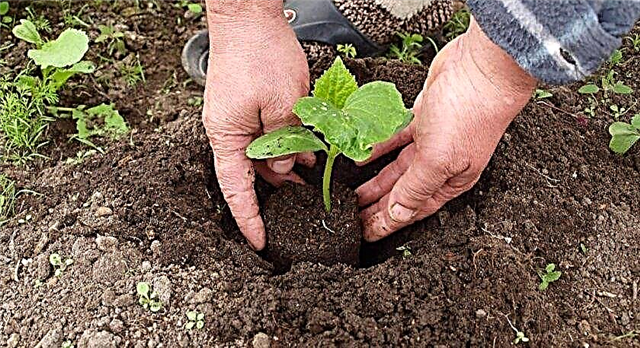
Most often, cucumbers are sown in open ground, but adult seedlings can also be planted.
Sowing seeds in the soil:
- Seeds are sown in a pre-prepared bed (seasoned with organics and dug up). With a bed width of 1.2 m, you can sow cucumbers in two parallel rows. In this case, the distance between rows should be at least 60 cm, and the distance between plants - 20–30 cm. With a bed width of 50–60 cm, cucumbers are sown in one row, with a distance between plants of 15–20 cm.
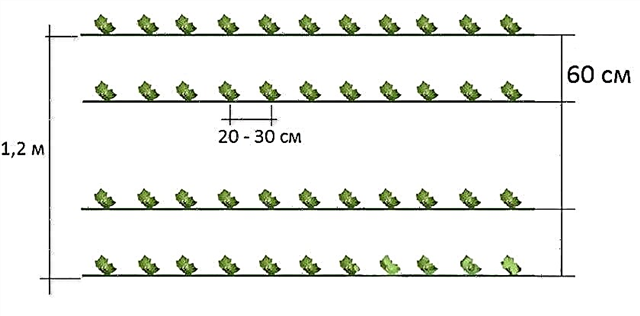
- Before sowing, mark the location of future rows and make furrows for sowing. The depth of the sowing furrows should not exceed 3-5 cm. Furrows are watered, they wait until the moisture leaves in the soil, and only after that they begin to lay out the cucumber seeds.
- If the gardener wants to accelerate the process of seedlings, the seeds are pre-soaked for a day in a damp woolen cloth, and then placed in a plastic bag with moist wood sawdust. A bag with sprouting seeds is placed in a warm place for 2-3 days, until seedlings and roots appear.
 Sprouted seeds are laid out along the planting furrows carefully, being careful not to damage the roots and sprouts.
Sprouted seeds are laid out along the planting furrows carefully, being careful not to damage the roots and sprouts. - Seeds in the furrows are covered with soil, the soil layer is leveled, after which the crops are watered and covered with agrofiber. Non-woven material helps retain moisture in the soil and reduces the need for watering crops.
Did you know? Cucumbers are a fast-growing crop, but various stresses during the growing season can result in bitterness in the fruit. Stressful situations include a sharp drop in temperature, a lack of moisture, and scarce soil.
Growing on the site
Cucumbers are sown in open ground already when the weather is stable and stable. In central Russia, the time for sowing cucumbers falls on May 10-15, in the south sowing is carried out much earlier - at the end of April. Most recently, this crop is sown in the northern regions, where sowing occurs on the first days of June.
It is not difficult to grow cucumbers in the open field. But in order to obtain high yields, the gardener must first prepare the soil on the bed, designed for growing this crop. First of all, it is necessary to fill the bed with organic matter. Cucumbers are very fond of nitrogen fertilizers, so they are usually fertilized with cattle manure or bird droppings.

For cucumber, fresh, not overripe manure is best suited. Organics are laid out along the perimeter of the planned beds in the same layer. For fertilizing 1 m² of cucumber beds, 1 bucket of manure is enough. Further, the fertilizer spread on the surface is deeply embedded in the soil. For this, the bed is dug with a bayonet shovel with a turnover of the reservoir.
The surface of the dug-in beds is leveled with a rake so that a small depression forms in the center, parallel to the longitudinal edges of the beds. It is in it that a furrow should be made for sowing seeds or a hole for planting seedlings. A longitudinal recess will trap moisture at the roots and prevent water from spreading when watering the cucumbers.
Retreating by 10-15 cm, a trellis is installed along the planting furrow for future planting. The trellis can be made of metal or wood, its height varies from 1.5 to 2 m.  As they grow, young plants are tied to the trellis with paper twine or a soft cloth. If the cucumber lashes outgrow the height of the trellis, the gardener throws them to the opposite side of the trellis and directs growth to the ground.
As they grow, young plants are tied to the trellis with paper twine or a soft cloth. If the cucumber lashes outgrow the height of the trellis, the gardener throws them to the opposite side of the trellis and directs growth to the ground.
Growing in a greenhouse
The greenhouse and the greenhouse differ from each other, although early cucumbers can be grown in both buildings. The greenhouse is heated with the help of a stove, gas or water heating, and heat in the greenhouse is generated naturally and depends only on the quality of the arrangement of this building. Greenhouses usually lay when there is no opportunity to heat high greenhouses, and there is a need for early production.
Did you know? The practice of growing cucumbers by people began about 4 thousand years ago. In ancient times, cucumbers not only ate, but also treated them with patients, and also used to whiten the skin.
When arranging a greenhouse, a pit with a depth of at least 1 m is dug around the future structure. Fresh horse manure is laid at a depth of 25-30 cm at the bottom of the pit, and the same layer of plant debris (branches, leaves, straw) is laid on top of it. All this “sandwich” is covered with a layer of fertile soil 30 cm thick. When the soil for the greenhouse is ready, the greenhouse frame itself is installed on top.
Typically, a greenhouse is low, not higher than 80 cm in height, so its space heats up quickly. The greenhouse lid is made of transparent materials (polyethylene, plastic or glass), which provides lighting for cucumbers and additional heating of the greenhouse with sunlight.  Two weeks before sowing seeds or transplanting seedlings, the greenhouse is abundantly watered with hot water at the rate of 10 liters of boiling water per 1 m² of soil. This procedure is needed to heat the organics in the lower layer under the greenhouse.
Two weeks before sowing seeds or transplanting seedlings, the greenhouse is abundantly watered with hot water at the rate of 10 liters of boiling water per 1 m² of soil. This procedure is needed to heat the organics in the lower layer under the greenhouse.
After watering with boiling water, the greenhouse is tightly closed. Warming up, organic fertilizers gradually gain high temperature and heat the upper soil layer in the greenhouse to a warm state. The entire structure is heated by hot soil.
Check out more

With the onset of heat, the gardener begins to air the greenhouse, daily slightly opening (10 cm) the greenhouse frame.
Ventilation is necessary because the inside of the greenhouse is hot and humid, which can provoke the occurrence of fungal diseases.
When the air temperature outside reaches +18 ... + 20 ° C during the day, the frame of the greenhouse is opened completely. In the closed position, the frame of the greenhouse remains all daylight, it is closed only at night. Around the middle of May, depending on the weather, the gardener ceases to close the greenhouse day and night.
By this time, cucumbers already reach the height of the structure, so they need support. As support for cucumbers, you can set a wooden high peg individually near each plant or take care of the construction of a common wooden or metal trellis. Further care for cucumbers in a greenhouse is no different from caring for a crop in the open field.

Care Rules
During the growing season, cucumbers require constant attention and care of the gardener. They need proper bush formation, timely irrigation and top dressing, mulching, garter, protection from diseases and harmful insects.
Irrigation and fertilizer scheme
Cucumbers are well-known "water chowders" and constantly need a slightly damp soil. But at the same time, the culture is afraid of moisture on the leaves, which can cause an outbreak of disease. That is why the culture is watered only at the root, without using leaf irrigation.
In the middle lane, cucumbers are watered 2 times a week, pouring at least 3 liters of warm water under the root of one plant.Watering plants is carried out only in the morning, in any case, before noon, irrigation should be completed.
This is due to the fact that drops of water that fall on cucumber leaves and stems must dry before evening. Otherwise, they will provoke the development of fungal spores and plant disease.
 It is very convenient to apply moisture to the cucumber roots using drip irrigation.
It is very convenient to apply moisture to the cucumber roots using drip irrigation.
Irrigation can be combined with plant nutrition. During the growing season, cucumbers are fed several times, with breaks of 10-14 days. The most saturated with nitrogen is liquid root top dressing from fermented bird droppings. Such top dressing must be prepared in advance and used all summer.
Preparation of feeding from bird droppings:
- A large tank, installed in a place protected from cold winds and well lit by the sun, is filled up to half with fresh or dry droppings of birds. Litter of chickens, geese, ducks, pigeons is suitable for these purposes.
- Next, the tank is filled with water, not being added to the edge of the tank 20 cm. This free space is necessary so that during the fermentation the top dressing does not spill onto the ground.
- The tank is closed with a lid so that during fermentation nitrogen does not disappear from the liquid fertilizer.
- The contents of the tank are thoroughly mixed daily with a long wooden stick. This is necessary in order for the solution to leave carbon dioxide.
- Depending on the outdoor temperature, after 7-12 days, the fermentation in the tank will calm down, which means the readiness of concentrated top dressing.
 The vegetable grower needs to remember that liquid feeding on bird droppings is a concentrated fertilizer and needs to be diluted with water. Immediately before the start of feeding, 0.5 l of concentrate is added to each bucket of clean water and used as intended.
The vegetable grower needs to remember that liquid feeding on bird droppings is a concentrated fertilizer and needs to be diluted with water. Immediately before the start of feeding, 0.5 l of concentrate is added to each bucket of clean water and used as intended.
Bush formation
In order for the hybrid to bear fruit well, do not let the bush form on its own. The main crop on the cucumber hybrid Grasshopper F1 is formed on the lateral stems, therefore, forming the load of the crop on the plant, the grower leaves 2-3 bundles of ovary on each lateral stalk, after which it pinches the lateral stem.

This plant formation is carried out to the top of the greenhouse or trellis. At the main stem, which has reached the upper limit of growth, pinch the growth point or direct it to weave towards the soil (down).
Soil care
Throughout the growing season, the ground under the cucumbers must be kept clean from weeds. Weeds are weeded out using a chopper or a Fokin ploskorez. Weeding under cucumbers is carried out every 10-12 days. After past heavy rains, the soil under the cucumbers needs loosening, which contributes to the entry of air and moisture to the root system.
To facilitate the care of cucumber plantations, experienced gardeners cover the garden with a mulching layer. As mulch, you can use a thick layer of straw or freshly cut grass, as well as a mulching double-sided agrofibre (black and white).

Agrofibre is convenient in that it can be used for several seasons. The black side is laid on the soil, which does not allow weed seeds to germinate, while the white side will face up and, reflecting the sun's rays, will not allow the soil to overheat.
If cucumbers are grown on trellis or stakes, then they must be tied to a support every 5-7 days. For garter choose soft natural materials or synthetic twine.
Important! The mulching layer not only protects the cucumber bed from weeds, but also retains moisture in the root layer, preventing it from evaporating.
Disease and Pest Prevention
Cucumbers are very prone to the development of fungal diseases, therefore, vegetable growers need to carry out preventive and therapeutic treatment of plants. Culture also needs protection against parasites that feed on plant juices.
Recommended Reading

As a preventive measure, gardeners are not recommended to leave the plant remains of diseased plants overwintering in the beds.
It is most reliable to burn such residues, and the beds where diseased plants grew should be shed with a solution of water and potassium permanganate.
It is also necessary to observe crop rotation and not grow plants belonging to the same family on the same bed.
The most dangerous diseases and pests of cucumbers:
- Aphid - tiny insects having black, green or gray coloration of chitin. They live in large colonies, multiply rapidly, and during the summer they can breed more than three generations of young animals. They are in symbiosis with ants, which bring them to cucumber lashes. As a prevention, gardeners are advised to destroy anthills located near the beds. If aphids have populated only a few cucumber leaves, they can be cut from the stem and buried in the soil. With small amounts of aphids on cucumbers, you can also try to wash it off with a directed stream of water. This should be done with caution, as a strong water jet can break cucumber lashes and leaves. With a large population of cucumbers with pests, it is necessary to apply the treatment with one of the insecticides: Karate, Aktara.

- Spider mite - black insects having a body length of several millimeters. Young spider mites have a transparent body, so it is difficult to notice on plants. The presence of the pest on the plant gives out the presence on the leaves and stems of a thin web.
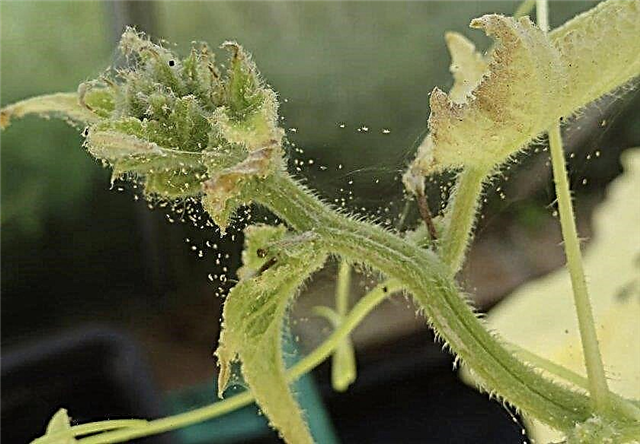 On small beds of spider mites, you can try to wash off the leaves manually, with a soft sponge and foam obtained from laundry soap. On not very infected plants, organic pest repellents can be used. It can be water tincture on tobacco or on hot ground pepper. Against a spider mite, leaf treatment of plants with insecticides is excellent.
On small beds of spider mites, you can try to wash off the leaves manually, with a soft sponge and foam obtained from laundry soap. On not very infected plants, organic pest repellents can be used. It can be water tincture on tobacco or on hot ground pepper. Against a spider mite, leaf treatment of plants with insecticides is excellent. - Powdery mildew - the disease has a fungal nature and develops from last year's spores wintering in soil or on plant debris. The main symptom of the disease is the appearance of white plaque on the leaves and stems of plants. Fungal spores spread in the garden with rain and wind. Damp weather contributes to the rapid development of the disease. As a prevention, you can use weekly spraying of plants with fresh milk or whey. At the first signs of the development of the disease, the cucumber plantation must be treated with fungicides ("Quadris", "Ridomil Gold").
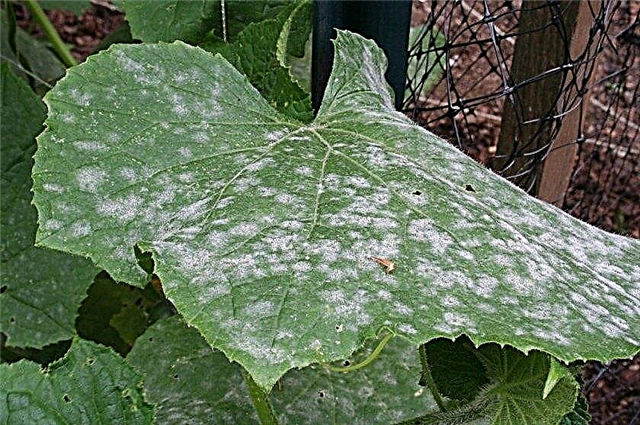
Harvesting and storage
Cucumber differs from other vegetables in that the gardener needs to take ripened fruits often, ideally every other day. During this time, on warm summer nights, the plant manages to grow young fruits. If you neglect the frequent collection of fruits, the yield of the bush will be significantly reduced.
One overripe cucumber delays both fruit setting and weight gain with already formed fruits. The collected fruits are placed in a container with smooth walls. Cucumbers can be stored for 7–10 days in a room with an air temperature not exceeding + 12 ° C, or on the bottom shelf of the refrigerator.
Important! It is undesirable to pick a cucumber from the whip, so as not to damage the bush. It is much safer to cut fruits with small, sharp scissors.
Cucumber hybrid Grasshopper F1 is worth growing for gardeners who want to get an early crop of fresh cucumbers. Subject to agricultural cultivation techniques, the ripening period of the fruits will be short, and the harvest will be plentiful.










 Sprouted seeds are laid out along the planting furrows carefully, being careful not to damage the roots and sprouts.
Sprouted seeds are laid out along the planting furrows carefully, being careful not to damage the roots and sprouts.
 On small beds of spider mites, you can try to wash off the leaves manually, with a soft sponge and foam obtained from laundry soap. On not very infected plants, organic pest repellents can be used. It can be water tincture on tobacco or on hot ground pepper. Against a spider mite, leaf treatment of plants with insecticides is excellent.
On small beds of spider mites, you can try to wash off the leaves manually, with a soft sponge and foam obtained from laundry soap. On not very infected plants, organic pest repellents can be used. It can be water tincture on tobacco or on hot ground pepper. Against a spider mite, leaf treatment of plants with insecticides is excellent.
